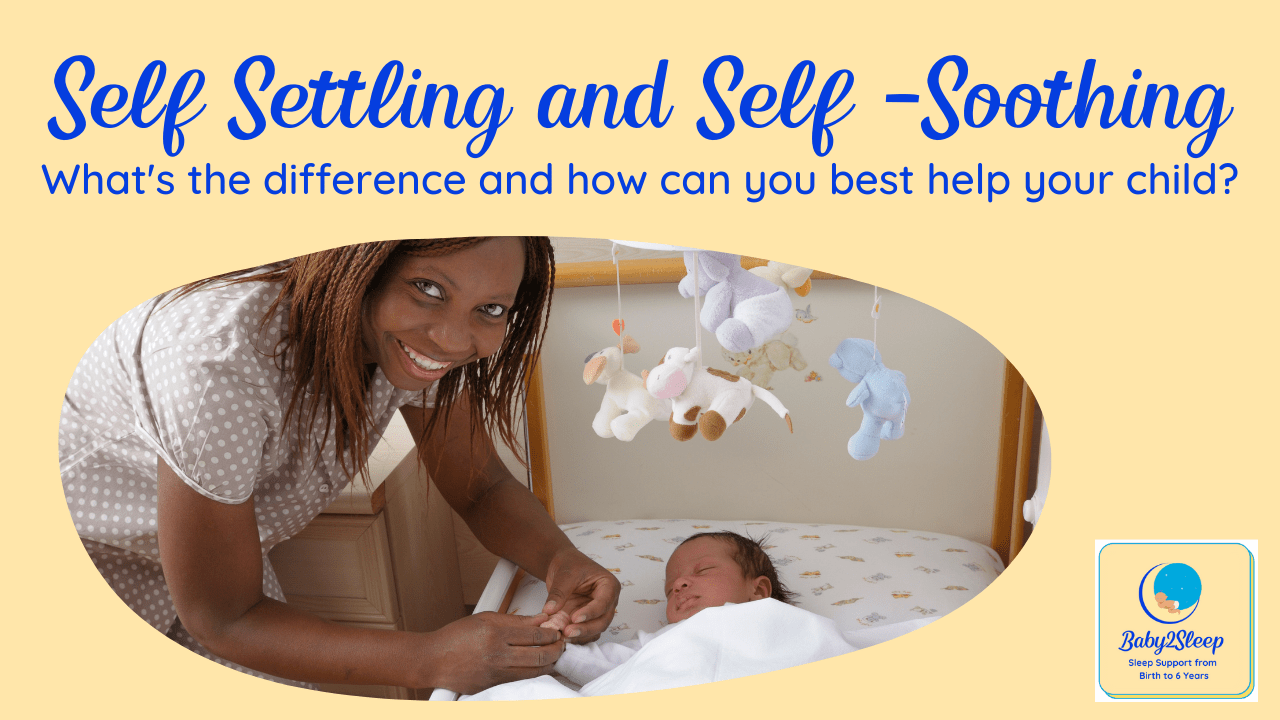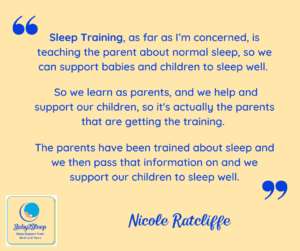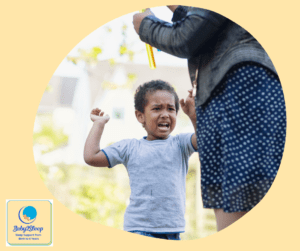
What’s the difference between self-settling and self-soothing and how does this impact sleep?
Self-Settling & Self-Soothing
Today’s video is about self-settling and self-soothing, two completely different things, but they can get confused with each other and cause quite a bit of distress for parents.
You can watch the video here, or read the transcript below.
So you’ll have probably heard people talk about how you’ve got to teach your baby to self-soothe in order for them to be able to sleep. That is not true.
Okay, some babies do self-soothe to a degree. They may soothe themselves by sucking their thumb or sucking their fingers. However, they’re not regulating their emotions. Other babies won’t have that thumb that they suck – they don’t have that thing and that’s fine and totally normal.
So let’s clear up what is self-soothing and what is self-settling because before you decide if you’re going to start making changes to help your little one sleep better, you need to understand what it is that you’re actually doing.
Self-Settling = learning to fall asleep by yourself
Self-Soothing – learning to regulate your emotions, for instance being able to stop crying or settle down after an upset
So let’s sort this myth of self-soothing and sleep out.
Self-Soothing
Self-soothing is about emotion regulation. It is not about falling asleep. It is not about sleep training. We cannot, by helping our children fall asleep, teach them to regulate their emotions. We cannot do that. They are not self-soothing. Self-soothing is emotion regulation. And it usually takes until adulthood to fully master it – and even then, we’re not perfect. I know I’m not. I’m terrible at it, especially when I’m tired.
As women, we tend to be in our 20s and men tend to be in their 30s before we are really able to properly self-regulate and self-soothe. So you can see why we can’t ask our babies and our young children to figure it out. We have to help them and support them on a journey to start that process of learning how to regulate their emotions, which is not something you’re going to master as a baby. But as they start reaching toddlerhood, we can start helping them find ways to manage those emotions a little bit better and understand what those emotions are that they’re feeling and give them tools to be able to help deal with it when they get those kinds of feelings.
Leaving your baby or toddler to cry alone at night, is not going to teach them to self-soothe, and it’s not going to help them to learn to self-settle either, but leaving them to figure out how to get themselves to sleep in their own time, isn’t helpful either. There are much better ways to intervene and help them learn, without it being too stressful for you or for the child.
Self-Settling
Self-settling is an entirely different thing. It’s not have anything to do with emotion regulation. Self-settling, simply put, is falling asleep.
We go to bed, we put our head on the pillow We think about things We process today’s events and we fall asleep. It’s no different for a baby or a child. They go to bed, they put their head on the pillow, they process, and they fall asleep. Obviously, that’s what we’d like them to do anyway. We know that that is not necessarily the case, but that is what self-settling should be. It’s falling asleep without help.
Now, when we talk about falling asleep independently, we’re not talking about leaving them on their own. Self-settling is about them just being able to fall asleep without you doing it for them. So you might sit with them if you want to, you might help them, you might talk to them while they’re doing it. You might just be in the room with them, but you won’t be physically rocking them to sleep or physically feeding them to sleep.
I must stress, there is absolutely nothing wrong with feeding or rocking your baby or your child to sleep at all. There is nothing wrong with co-sleeping either if it’s working for you, if you’re okay with it, if your baby is happy and you’re happy and you’re all managing, there is absolutely nothing wrong with this.

However, if you’re at a point where you’re doing something at bedtime to get your little one to go to sleep and you then need to do the same thing every hour to 2 hours throughout the night, and it’s become something which you’re not happy with, you might choose to start looking at making some changes, taking away the thing that you do to get them to sleep (feeding or rocking) and replacing it with other things which they can do for themselves- that is the essence of self-settling
So it’s not about saying, I’m going to cut this off now and you’re not having any help from me again. It’s saying, okay, this particular thing seems to be the trigger – you’re needing it to fall asleep when you wake up out of a sleep cycle, you’re needing me to help you go back to sleep doing this exact same thing. And actually, do you know what? I can’t do it ten times a night. I think I’m ready now as a parent to make some changes.
So that might be the point where you say, Right, well, I’m not going to do this anymore, but I’m going to do something else instead. I’ve done my research, I’ve made a plan. I know what I need to do and I’m okay with that because I’m going to stay with you and I’m going to help you and I’m going to pick you up and I’ll help soothe you. I’ll help you calm down if you’re crying,
Is crying good or bad?
So many people go, oh, my God, my baby’s crying. This is so wrong.
Actually, this is all the start of the self-soothing process, the emotion-regulatory process. I’m not saying it’s a bad thing to cry or a good thing to cry.
However, a baby can’t have a conversation with you. They want to tell you whether they’re hungry, whether they’re tired, whether they’re frustrated. What are those feelings that they’re getting in their tummy? Are they in pain? What is it that they’re actually feeling? They can only communicate that really through crying.

If it’s something that’s a negative feeling or that they’re needing something from you, they’re telling you. So what we do is we respond to that. So their cortisol levels increase slightly while they’re actually crying because that’s what happens – they cry, they feel a little bit stressed their cortisol levels rise.
As a parent, we then respond to that rise, we respond to that crying, and we help bring those cortisol levels down. What’s happening at this point in their body and their brain is going, so this is stress, and this is how we release stress. Okay, that’s not so bad. That’s not quite so traumatic.
Okay, hang on. I’m feeling a bit frustrated again and I’m feeling a bit upset so I’m going to cry. Then I’m feeling a bit stressed, and you’ve comforted me and you’ve helped me and my cortisol levels have come down, and I’m not so stressed.
That’s not a bad thing. If your baby is constantly crying and you’re not responding to them, that’s a different thing entirely. But what we’re doing here is we’re teaching their body to get used to a particular response within itself. This is useful for when they’re older, because at the end of the day, if they’re not used to feeling a bit of stress and it is responded to, and figuring out that actually sometimes it’s okay to feel a bit of stress as long as we’ve got some tools to level things out, how are they supposed to manage on their first day at school? How are they supposed to manage when they go to a class or something?
You drop them off at preschool or at a dance class. And suddenly, especially when you think about how COVID has been over the last couple of years, you drop them off, you walk away. We need to make sure that they’ve got some kind of toolkit to help them figure out how to go from, “oh, I’m not so sure about this” to “actually it’s not so bad because I know what I’m doing here.”
So what we’re saying is if your baby cries, you respond to that cry, and it helps bring those cortisol levels down. So it’s not a bad thing. It’s communication and it’s an opportunity for us as parents to help and support our child on that journey.
So responding to a baby’s cry at night isn’t about them fully self-soothing – this is about the very, very beginnings. This is the start of a very, very, long journey into adulthood of managing their emotions and learning to self-regulate. It’s the beginning, but we have to help them as parents by blocking it and saying, no, I can’t ever let my baby cry. We’re not actually giving them an opportunity to have those feelings, to actually deal with them, which in later life isn’t necessarily a good thing.
How can you teach your baby self-settling?
What I’m saying is we’re going to help our baby or child learn to settle themselves to sleep, but we’re not saying for them to do it on their own. We’ll help the baby do it in a different way, without being fed or rocked. This process takes time, and if the baby gets distressed, or upset,
you help and respond to them and help them to bring their cortisol levels down. That’s what we’re doing with self-settling, and it eventually gets to the point where you can just put them down and they will just kind of go, yeah, I’m secure in my environment. I’m secure where I am. Everything is good. I’m not so overtired at bedtime because actually everything’s been good during the day. We’ve had a really good bedtime routine. I know what’s coming, and I feel quite happy here. And you can put them down and walk away.
That’s where you get to. But that’s not where you will be at the beginning. So when people are talking to you about you’ve got to teach your baby to self-soothe – if your baby’s up multiple times and you’re struggling, you want to help them with self-settling, getting themselves to sleep with your support at first, and then you can start taking that support away as they need you less. And that’s not a bad thing.
What does this have to do with self-soothing?
All through this process of teaching your baby to self-settle and respond to their distress while they learn, you are starting to put little nuggets in their heads to help them work out what these feelings are and help them with the start of their self-soothing process. Self-soothing itself is massive – as I say, it’s emotion regulation. This is not something we figure out overnight.
You’ll find as your child gets that little bit older, this is where we really, as parents have to start putting these foundations in place and really helping them because in the run-up to two years old, their independent spirit starts to come out. They start to push those boundaries. Suddenly they’re able to communicate a bit better, but then they become frustrated because they might want to tell you how they’re feeling, but they don’t really know what it is that they’re feeling, so they can’t actually communicate with you.
This then might result in a tantrum because actually they’re feeling quite overwhelmed about something, and it doesn’t have to be a negative thing. Excitement can actually kind of lead into a tantrum, because they don’t know how to express what they’re feeling or they don’t know how to communicate it because they’re not there verbally. So, this is our job as parents to help our children learn to be able to communicate both verbally and through doing things.
If they’re feeling angry, they might not be able to tell you that they’re feeling angry. But if we can label an emotion, for example, if we can see that they’re feeling quite angry about something, we can label that for them. So this might be a two-year-old, they don’t necessarily know what anger is, but they’ve actually got a feeling that’s going on. Something’s happened. And as a parent, we can tell that that feeling is an angry type of feeling. So we can then label that so that child then knows that this feeling that I’ve got right now, it’s got an actual title to it. So now I know what it is.
As a parent, we can then say, okay, you’re feeling angry. And we can then give them tools to manage it. So it might be when you’re feeling angry, maybe you want to jump up and down on the spot, or maybe if there’s a pillow, you might punch a pillow, or you might dance or clap your hands. We can start trying to give them tools. We can teach them things like how to take deep breaths. So we can teach them to breathe in and out, and we can do this with them.
We’re not saying do it on your own. We’re saying we’ll do this with you. We’ll help you on this journey to figuring out ways to calm yourself down.

With Sofia we had the calm down step. People go on about the naughty step but we didn’t have a naughty step because naughty is about telling your child that they’re naughty. That’s not necessarily a positive thing because you’re just reinforcing the fact that you’ve got a naughty child. And they’re kind of going, oh, I’m naughty. It’s normal. We don’t want that.
So instead we had a calm down step. And sometimes if Sofia was feeling really quite overwhelmed, she’d walk out of the room and I’d go, “where are you going? ” she goes, “I’m just going to go and calm down the calm down step” she’d go and she’d sit down and she’d sit there and she’d start doing her deep breaths. This was her taking what I had taught her over time and actually going and putting it into action herself, which is incredible. And I think she might have only been three when we were doing that, which is amazing for children that age to be able to do that.
But again, she hasn’t just figured that out on her own. That was me learning all about stuff and putting these foundations in place to help support her. And that’s what it’s all about. So we understand what it is our child is feeling. We put a label on that, and We can tell them what that feeling is that they’ve got. We can then give them tools to manage it and we can tell them it’s okay and it is normal. It’s okay to feel like this, and It’s okay to feel angry and It’s okay to feel frustrated. It’s a normal emotion. Because again, if we start alienating things and say making it so actually, it’s not a good thing to be this way, we’re going to make them feel like they can’t express their feelings.
But we all get angry, we all get frustrated. I’m absolutely terrible for it. I’m probably one of the most highly-strung people you will ever meet. It’s ridiculous. I don’t deal with sleep deprivation very well, and if things are not going my way, I do not cope well. I have to really work hard to manage my own emotions. I’m 40 and I have to really work hard at that. I absolutely lose my cool far too many times for my own liking. It’s normal. It’s me. And what I’ll do is I’ll say, Right, okay, if this happens, rewind, apologise for my behaviour, model what I want to do, and don’t do it again or try my hardest not to do it again. But again, we’re not perfect. And that’s okay because nobody is.
And again, if we keep aspiring to be perfect, our children aspire to be perfect. Because they think that that’s what we are, because we don’t actually show our flaws. We’re not doing them any favours.
Is sleep training good or bad?
So self-soothing and self-settling are entirely different things. I know I’ve completely gone off at a tangent here about other things, but again, teenagers, very quickly, teenagers, they go through this huge part with hormones. Again, this is when they need us as parents. Parents are there to support their children through these huge development stages and help them understand how to regulate their emotions and soothe themselves. This is all self-soothing. We’re not talking about sleep training when we’re talking about that. We’re talking about emotion regulation.

Self-settling is the thing that tends to be linked more with sleep training. However, I must stress, sleep training for me is a massive big label that goes across a whole broad spectrum of things.
It’s not about cry it out.
If you go over to America or you see ugly things. I’m not going to say the names of other people. Very much in the controlled crying, leave your baby to cry alone type camp.
But then, at the other end of the spectrum. There are people that say making any change or if your baby cries at all, that is wrong.
I’m firmly in the middle, allowing the baby to cry a little where they need to and for them then to feel comforted and understand that they are loved.
Sleep training for me, is teaching the parent about normal sleep so we can support our babies and children to sleep well. So we’re learning as parents and then we help and support our children
It’s actually the parents that are getting the training. The parents have been trained about sleep, and we then pass that information on. We support our children to sleep well.
We are basically helping our children to settle themselves to sleep with our support and with us responding. There’s nothing wrong with, that as long as you do it in a way. That you’re comfortable that your baby is okay. They are loved, they are secure and you are not just leaving them to just sob their heart out into complete distress and just not responding. It’s a different thing entirely.
As long as you’re all okay with whatever method you decide to do, it’s fine. But it’s normal to completely lose it sometimes too, so don’t worry. It’s fine children do it, adults do it. It’s just a normal part of life and you can’t be too hard on yourself.
How can I help you
If you feel like you want to make some differences in your family’s sleep, then I can definitely help you. I will show you how to make a plan that achieves the changes. You want to make with a minimum of distress to your child. I have very recent experience of doing this myself. I will be able to give you a realistic plan and help you to follow it through.
If you want to see a little bit about how this works then head over to my YouTube channel and look at the playlist called My Sleep Journey. I
n January 2022, I decided to make some changes to my daughter’s sleep plan. For the sake of the whole family
- for her to stop breastfeeding in the night as she no longer needed it
- for her to learn to sleep through the night. To settle herself without intervention from me if she woke up
- for her to move from a cot to a bed, and move from sleeping in my room. With me to sharing a room with her six-year-old sister
- eventually for her to be able to sleep with her sister consistently without disturbing her
Watching through those videos you will see a bit about my thought processes and the plans that I made. You will see how some of the nights went, good and bad, and the interventions that I gave. You will see the reality of things when they didn’t always go to plan and a couple of nights. When I didn’t hold it together as well as I might have done. And then you will see the change as Alyssia learns to sleep in her new big girl bed. How proud she is at her achievements.
This is the reality of making changes – it can be messy and it takes time. But if you have decided that the current situation is not good for your family. Then it is worth persevering with.
If you would like me to help you, then the best thing you can do is to buy the Build your Own Sleep Plan, which most closely matches the age of your child. You will receive a series of videos that will help you understand. A bit about what normal sleep looks like at that age and what you can realistically achieve. On top of that, you get two months ‘ support from me in a private Facebook group. Where we can talk about your specific situation, your plans and the things that happen while you implement them. I can help you with little tweaks until you get to where you want to be.

